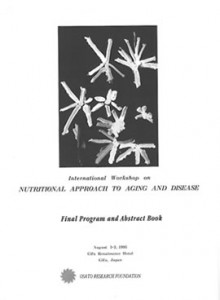| Title | Bio-Normalizer Approach in Management of Patients with Diabetes Mellitus and Hepatitis |
|---|---|
| Year | 1995 |
| Author | L.G. Korkina; E. Samchatova; M. Balabolkin; I.B. Afanas’ev |
| Publisher | International Workshop on Nutritional Approach to Aging and Disease |
International Workshop on
NUTRITIONAL APPROACH TO AGING AND DISEASE
Final Program and Abstract Book
August 1-3, 1995
Gifu Renaissance Hotel
Gifu, Japan
OSATO RESEARCH FOUNDATION
BIO -NORMALIZER APPROACHES IN MANAGEMENT OF PATIENTS WITH DIABETES MELLITUS AND HEPATITIS
L. Korkina, E. Samochatova, M. Balabolkin, and I. Afanas’ev
Institute of Pediatric Hematology and Centre of Diabetes, Russia
The open randomized controlled clinical trials on Bio-normalizer (BN) have been performed in adults suffering from insulin-dependent diabetes mellitus (type 1) and in children with chronic virus hepatitis B (HBV) and hepatitis C (HCV). The control group patients were treated with conventional therapy. The experimental group patients, in addition to basic therapy, were given 9 grams of BN daily for 30 days. Therapeutic efficacy of BN was estimated by means of clinical examination, specific disease marker examination, biochemical and hematological analyses, and the free radical status determination. It was found that the short-term BN administration led to significant improvement in the clinical conditions of patients with diabetes mellitus. Specific markers of diabetes in the blood and urine decreased simultaneously. The course of BN therapy affected the impaired cell immune system increasing the level of CD 14+ monocytes and CD 4+ /CD 8+ lymphocyte ratio. BN administration restored the normal levels of superoxide and nitric oxide production by blood monocytes as well as the contents of glutathione reduced and oxidized. Furthermore, BN therapy showed a high efficacy in the patients with HCV and HBV that was characterized by decreasing the level of marker liver enzymes (AST and ALT) down to the normal values. MDA content in the blood plasma and hydroxyl radical release from blood leukocytes were suppressed after the BN administration. We suggested that likewise α-lipoic acid, a major molecular reason for the BN therapeutic effects in diabetes and hepatitis may be the BN capability of modulating the organism’s free radical status.
